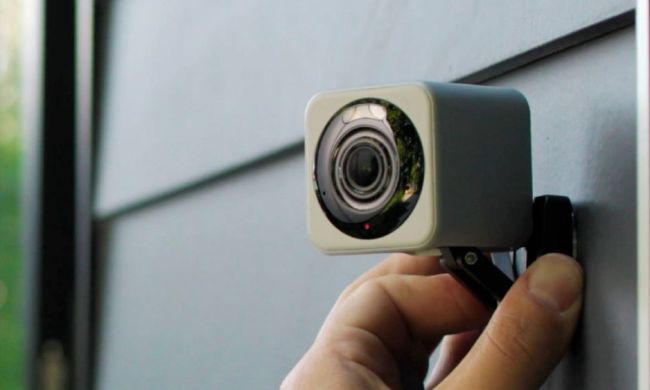Does your home get too hot in the summer, even as your utility bill continues to climb each year? You may want to consider a smart thermostat, which is an evolution in heating and air conditioning technology. These thermostats can keep homes climate-controlled while promoting energy efficiency.
We reviewed two of the top-selling smart thermostats on the market. Both the Nest and Ecobee models fared well in terms of cost, energy efficiency, appearance, connectivity, voice assistance, and more. However, one product had the edge in the critical areas of voice assistance and sensor technology.
If you’re working with a tight budget, be sure to take a look at the best Nest thermostat deals available now.
Cost
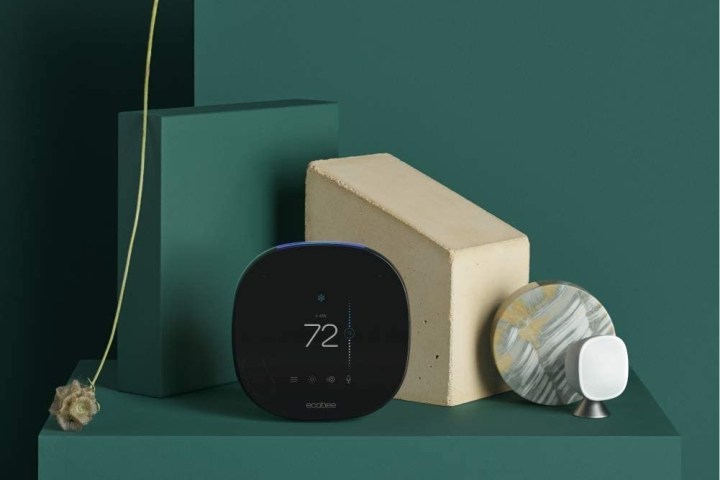
Both the primary Nest Learning Thermostat and the Ecobee SmartThermostat cost $249 retail. While they can sometimes go on sale, there’s no predicting when this will happen.
However, both brands also have budget options to consider, and they’ve made some important updates for these options in 2020.
- First, while the standard Nest thermostat is still for sale, Google has also the latest Nest thermostat while retails for $129 and replaced the Nest Thermostat E entirely (which is no longer available). Both Nest thermostats share very similar names, but it’s important to note they are two different products: The cheaper version has fewer sensors and learning capabilities to help keep the cost down.
- Ecobee, meanwhile, has reduced its available thermostat models to just two. The standard SmartThermostat and the older Ecobee 3 Lite, which is available for $169. Since the SmartThermostat is simply an upgraded version of the previous model, we suggest sticking with it unless you really need to save more money.
As for subscriptions, you generally don’t need to worry about ongoing fees for smart thermostats. They are free to use once they are set up and connected to their mobile apps.
Winner: Tied
Energy saving and reports
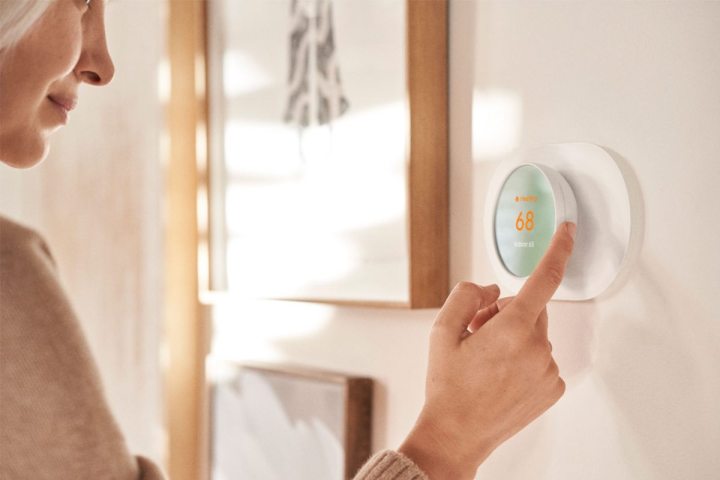
One of the primary reasons many people choose smart thermostats is because they want to cut down on utility bill costs. Although both models mentioned here can help you reach your energy goals, the Nest approach is a little more user-friendly.
When you adjust the temperature in a way that will result in energy savings, a leaf icon appears on the thermostat. Using the Nest Thermostat for heating and setting it to 62 degrees or below will always get you the leaf, as will using the gadget to cool your home and setting the thermostat to 84 degrees or warmer. Nest will then send monthly reports showing your costs, how much you’ve saved compared to previous months, and why costs are different (changes in weather, etc), culminating in an overall Leaf score for the period. It’s very easy to digest and highly focused on saving energy.
As the Nest Learning Thermostat gets smarter and learns the household’s preferences over time, you’ll see the leaf icon show up on the display whenever you choose temperature settings that save energy based on your preferences and habits. The leaf icon doesn’t provide more information besides the icon cue, but Nest’s support documentation about the feature indicates it will challenge people to set the thermostat higher or lower than usual. Making one-degree tweaks could save up to 5% on energy bills.
Ecobee’s SmartThermostat is very similar, using eco+ software and a scheduling assistant to learn when the house is active and adjust the temperature likewise. However, the interface and operation aren’t quite as intuitive as the Nest Thermostat. Ecobee produces HomeIQ reports that detail similar stats about energy saved and home efficiency, and although it’s not as easy to read through as Nest’s version, there is extra information like a comparison with others in the Ecobee community.
You might also like to know that the SmartThermostat is solely a hard-wired smart thermostat, whereas the Nest Learning Thermostat can operate off of either a home’s electricity or batteries in the event of a power outage. If a person lives in an area characterized by severe weather that often causes power outages, the choice of two power sources in the Nest product could be advantageous. That additional option, combined with its smart energy-saving feature, makes Nest the winner here.
Winner: Nest Learning Thermostat
Looks
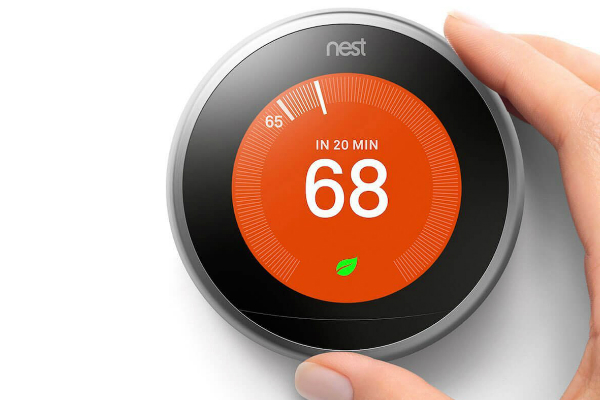
Both thermostats have rounded shapes. However, while the Nest Learning Thermostat is perfectly round, the SmartThermostat is a bit more squared. Both have high-quality screens that can display a variety of information.
You can buy the Nest Thermostat in stainless steel, polished steel, black, mirror black, white, brass, or copper. The Nest Learning also has a far-sight feature to detect activity in distant parts of the room, and it lights up so it can act as a night-light of sorts.
The SmartThermostat has a black front piece with a blue strip at the top, and it doesn’t have color options available like Nest.
Winner: Nest Learning Thermostat
Nest vs. Ecobee Thermostat adjustment

A look at the specifics of each device reveals that although they look similar, there are slight differences in how to make temperature adjustments.
The Nest device uses a dial mechanism courtesy of an exterior ring that you turn manually to change the temperature. If you prefer the same temperature-adjustment technique used for conventional thermostats, the Nest Learning Thermostat is a good choice. It also employs near/far activity sensors so that the thermostat has a good idea if anyone is at home, and can automatically adjust itself accordingly.
The SmartThermostat utilizes a touchscreen. For those already accustomed to touchscreens on their smartphones, tablets, and home appliances such as ovens, using the SmartThermostat to alter the temperature is a natural extension of those activities.
When people invest in a SmartThermostat, they can also purchase wireless room sensors. These accessories detect occupancy and adjust room temperatures automatically. Each SmartThermostat also comes with one SmartSensor, a lot of added utility for homes where the thermostat is in an awkward position that doesn’t indicate the temperature where people are active.
You can also choose to average the temperatures of selected rooms with sensors regardless of the presence of people with the SmartThermostat. Convenience is one of the primary advantages of having a smart home, and this smart thermostat certainly delivers it.
Concerning the Nest Learning Thermostat, you can buy Nest Temperature Sensors separately. They require you to specify the desired temperature in a room at a particular time of the day, then the Nest responds to that input, making it a must-have accessory for large smart homes. Users can prioritize different rooms as needed.
Winner: Ecobee
Compatibility with other home energy devices

Both devices connect with several energy devices for easier use.
The SmartThermostat recognizes when a home has a ventilator and uses cool outdoor temperatures when appropriate to reduce dependence on your home’s air conditioner. In homes with dehumidifiers, the SmartThermostat can regulate indoor humidity to prevent frost buildup in colder weather coupled with high-humidity indoor environments. It can also connect with humidifiers, HRVs, and other accessories to make sure they are used properly as well. The Alexa compatibility also allows for more complex smart home setups.
In addition to the SmartSensor, Ecobee has also released additional smart security devices for its platform. These include a different type of SmartSensor designed for door and window security and a SmartCamera to keep watch over indoor spots in the home. These all function on the same platform and make it easy to combine your thermostat with a basic security system via the same app.
Conversely, Nest offers a feature that’s beneficial in homes with heat pumps and auxiliary heat. Known as Heat Pump Balance, it allows you to choose how much auxiliary heat to use, which is handy since such heating options can be expensive. The Nest thermostat also figures the heat pump’s efficiency, the current weather, and weather forecast into the mix with the Heat Pump Balance feature activated, relying on data to determine the best auxiliary heat usage.
The Nest thermostat also fits in very well with all the Nest family of smart products (including security cams, smoke detectors, and more), allowing you to control everyone easily from the
Winner: Tie
Geofencing
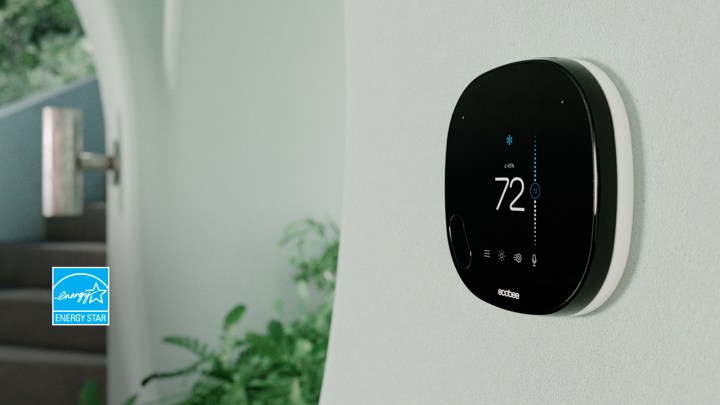
Geofencing refers to the ability for a smart thermostat to know when you’ve left the home, typically by tracking the location of your phone. Geofencing isn’t necessary with either the Nest or the Ecobee models, since they both use their own sensors to see if anyone is in the house. But if you are interested in the feature, then the Nest has a built-in Home/Away function through the
Winner: Tie
Voice assistant connectivity
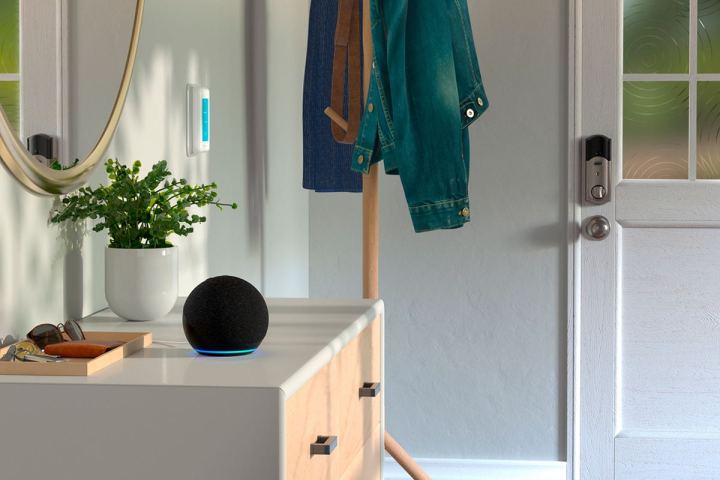
Both the Nest Learning Thermostat and the Ecobee SmartThermostat work with Google Assistant or Alexa, albeit in different ways.
When using an Amazon
It’s impressive that you can use the
Winner: Ecobee
Installation

If you want to tackle installation yourself, then you’ll find the process more or less identical for both thermostats. You’ll have to unmount your old thermostat and make sure you have the necessary wiring to connect the smart mode. A number of wires — typically four to five — will need to be carefully detached and then re-attached in proper positions on the new thermostat. Depending on the state of your wiring, you may also need to do some stripping or other minor repair work at the same time.
Both Nest and Ecobee offer very good instructions for this process, including detailed diagrams and helpful video guides. Both also allow you to search for local authorized professionals in your area if you decide to have someone else tackle the job (usually a $50 to $100 service, depending on your location).
Winner: Tie
What’s the verdict?

Because both thermostats offer the same basics, they’re evenly matched and you won’t go wrong with either one you choose. If you’re not a fan of voice assistants or already own an Echo device, the Nest Thermostat may be the better option with its exceptional design. On the other hand, if you have always wanted a voice assistant device like
There are other smart thermostats on the market, notably simpler models from Amazon and Resideo, but when it comes to features and performance no one really beats Nest and Ecobee, so we suggest sticking with these brands if possible.
No matter which device you buy, remember that smart home thermostats usually have benefits and drawbacks to examine before making a purchase. When you find the thermostat best-suited for your home, you’ll be impressed by the ease with which you can control the house’s temperature no matter the season.


